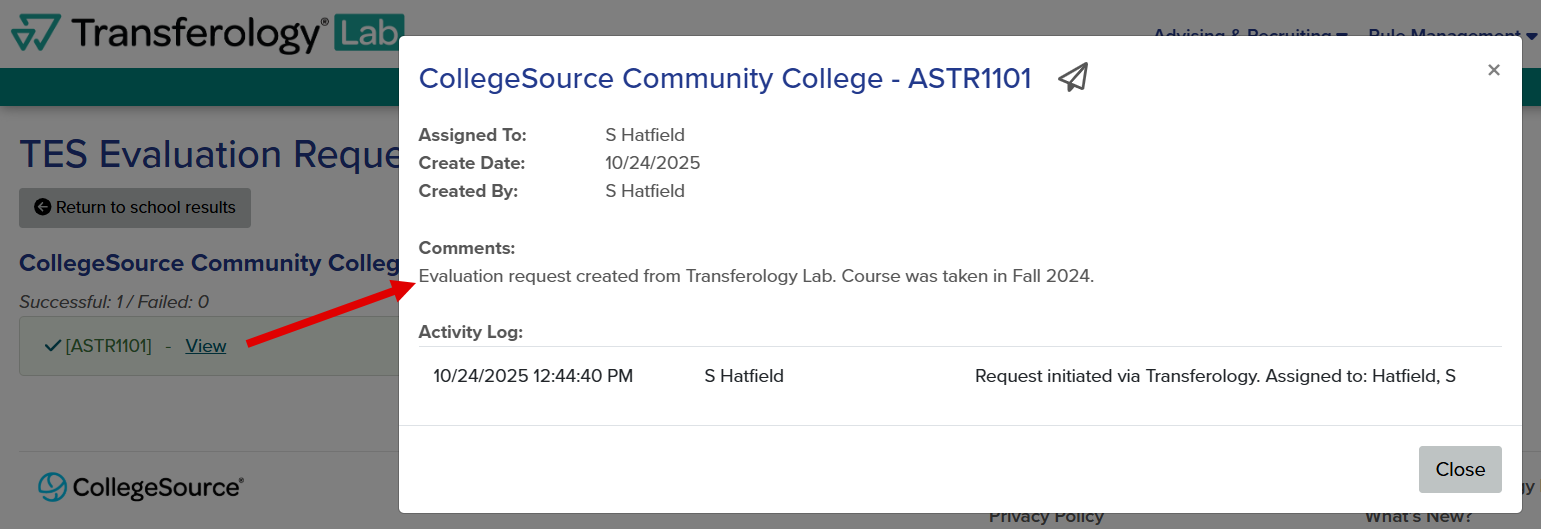TES Mode: Create Evaluation Tasks from the Transferology Lab
TES Mode allows Transferology® Lab users to send evaluation tasks to TES® directly from the Lab. Individuals sending reviews via TES Mode are not required to have a TES account, but the institution must have a TES subscription. This article provides an overview of the process for setting up TES Mode in the Lab and creating and routing evaluation tasks.
In this article:
Access and Role Permissions
Within the Transferology® Lab, users with the TES Evaluation role can create evaluation tasks from courses appearing within six areas:
| Area | Use | Role Permissions |
| Course Bundles | Review courses from the Maybes tab when viewing Match results. | TES Evaluation |
| Recruit Students | Review courses from the Maybes tab when viewing Match results. | TES Evaluation + Recruiter |
| Advise Students | Review courses from the Maybes tab when viewing Match results. | TES Evaluation + Advisor |
| Check Transfer Rules | Review courses without active rules within a Department. | TES Evaluation + Transfer Specialist |
| Popular Courses | Review courses that do not have active rules that students have entered into Transferology. | TES Evaluation + Transfer Specialist |
| Unknown Equivalencies | Review courses that do not have active rules for students who have viewed the institution's Match results page. | TES Evaluation + Transfer Specialist |
A transfer evaluation rule is active if the institution would award transfer credit if a student takes the class in the current term.
Required Setup
TES Mode: Creating Evaluation Tasks through Transferology and uAchieve provides an overview of the functional setup needed in TES® and the Transferology® Lab before using TES Mode.
Assign the TES Evaluator Role
The School Administrator must assign the TES Evaluator role to all users who initiate evaluation requests. As noted above, other roles are required to access specific Lab areas containing TES Mode. For further information, see Update Transferology Lab User Accounts: Information, Roles, Deactivation, and Reactivation under Related Articles.
General Information
The School Administrator will need to update multiple fields in the General Information tab of School Management, within the TES Evaluation section. For more information, see Configure General Information in the Transferology Lab under Related Articles.
Create Evaluation Tasks
The example below illustrates how to use TES Mode after viewing Match results within a student profile via Recruit Students. The procedure for using TES Mode is similar across all applicable areas of the Transferology Lab, but there may be some variance. For example, TES Mode will appear as a tab in all areas except Check Transfer Rules, where it is a button.
To create an evaluation task or tasks from within the Transferology® Lab:
- Select TES Mode.
- Select the course or courses needing review.
No more than 10 courses or course groups (see below) can be submitted at a time.
Not all courses (e.g., standardized exams) can be reviewed by TES Mode. When attempting to add these courses, a notification message will appear.
- If the School's Administrator has enabled the Allow users to assign TES Evaluation requests to a specific user checkbox in the General Information tab of School Management, users will see the option to Assign these requests to a particular individual.
- The Default Assignee is selected by default.
- Use the drop-down arrow to select from a list of eligible recipients (all individuals with the SERVICE EVAL user right in TES®).
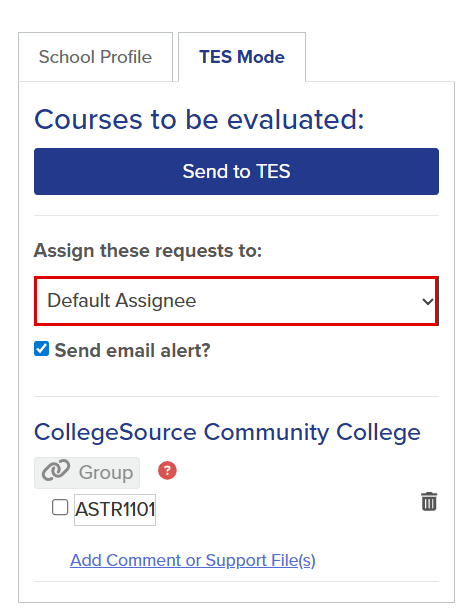
- The Send email alert? checkbox will be marked by default if the school's TES Administrator has turned the default setting for evaluation task actions that have a SEND EMAIL checkbox setting On in TES.
- If not marked, select the checkbox. It is best practice to send an email alert to evaluators so the users know a task has been assigned.
Changes to the SEND EMAIL checkbox default setting in TES will appear in the Transferology Lab each time a page with TES Mode functionality is loaded.
- Courses from a single institution can be sent as a single evaluation task if needed.
- Select the checkboxes to the left of the course codes.
- Then, select Group.

Grouped courses will appear as shown. To remove the courses from the group, select unlink courses.
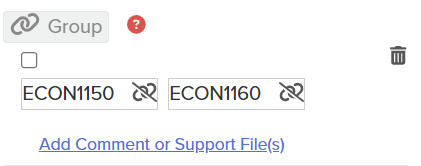
- A comment and support files can be added to the evaluation task if needed.
- Select Add Comment or Support File(s).
By default, a message will appear in the Comment field of courses that have never been grouped, noting that the evaluation request was created from Transferology Lab. It will identify the term that the course was entered in Transferology.
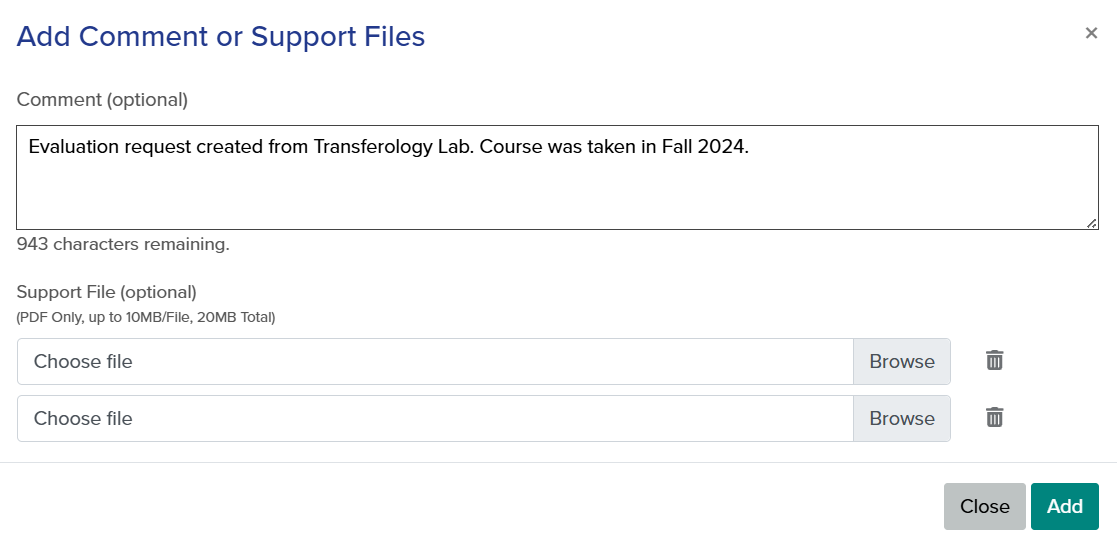
b. Add to or adjust this comment. Up to 1024 characters can be entered into the Comment field.
c. Select Browse to upload a PDF (or drag the file).
- Two PDFs can be uploaded. Each file must be less than 10 MB, and the combined 20 MB limit cannot be exceeded.
d. Select Add.
Once added, a hyperlink will appear under the course indicating the number of support files attached. Select the link to edit the comment and add or remove support files.
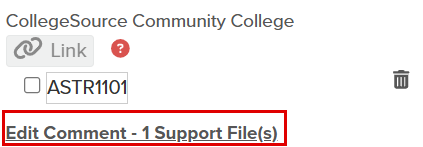
- Select Send to TES.
![]()
A message will appear indicating the status of the evaluation request.
Successful: The evaluation request has been sent to TES.
- The user can select View to see details of the request.
- Users with the TES Evaluator role permission can track the evaluation process through the Lab's TES Evaluations page (see Related Articles).
Failed: The evaluation request was not sent to TES. This message may appear if:
- The institution has reached its daily evaluation request limit.
- The default assignee for evaluation tasks is not defined in TES.
- An equivalency for the course already exists in TES.
- An open evaluation for the course already exists in TES.
- At least one course was not found in TES.
- An evaluation task for the course was previously created from the Transferology Lab.
- Linked courses are not within the same catalog edit.
- An error occurred (please contact CollegeSource).



